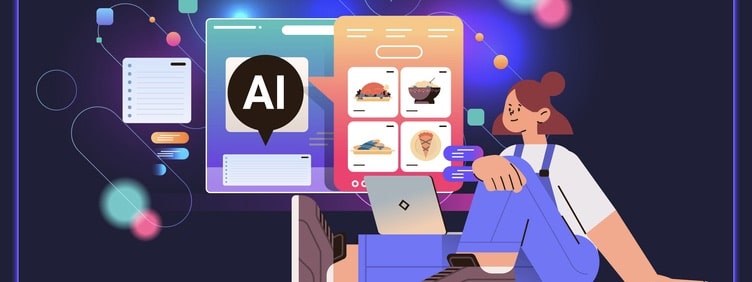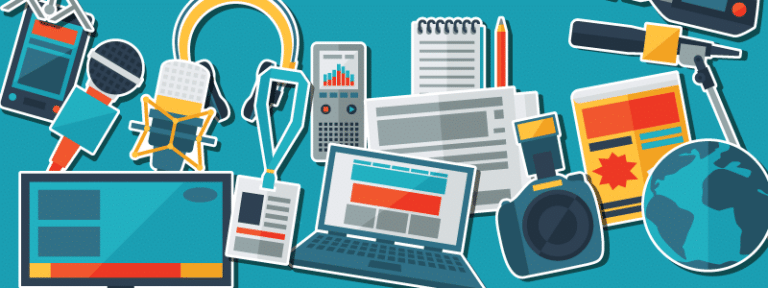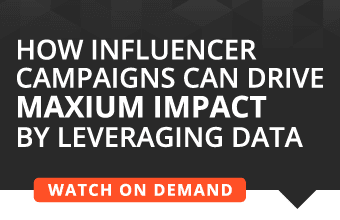Influencer marketing is integral to any brand’s PR strategy as it allows you to reach a vast audience through trusted social media personalities. Influencers have the power to direct consumer behavior, enhance brand visibility, and create authentic connections with your target audience. However, ensuring genuine engagement in influencer marketing campaigns can be challenging.
As audiences become more discerning, they seek genuine interactions and value from content. Many influencer partnerships fail to deliver on this front, leading to disengagement and skepticism from the audience. Yet, establishing authentic connections between influencers and their followers is crucial if they are to drive meaningful results for your brand.
One of the potential solutions to this problem is generative AI. By leveraging AI-powered tools, you can easily and quickly craft more personalized and authentic content for your brand. Generative AI allows influencers to create original and compelling posts that align with their unique voice and resonate with their audience. This, in turn, fosters more authentic connections, making your influencer marketing campaigns more effective and driving higher engagement levels among your target audience.
Several brands are already jumping into the AI bandwagon in their influencer marketing campaigns. According to the 2023 Influencer Marketing Hub report, over 63 percent of brands plan to enhance their influencer campaigns using generative AI this year.
Below, we’ll look at how incorporating generative AI into your PR strategy can help you unlock the true potential of influencer marketing and establish more meaningful connections with your audience. Before that, however, let’s answer this question—how does generative AI fit into influencer marketing?
Understanding generative AI in influencer marketing
Generative AI is a relatively new technology that allows computer programs to produce original content autonomously. These programs rely on complex algorithms and deep learning models to learn patterns from existing data and generate new and unique outputs. In influencer marketing, this technology makes it possible to create diverse content types like text, images, and videos based on influencers’ preferences and audience insights.
The main thing that sets generative AI apart from other types of AI used in marketing is its ability to create entirely new content rather than just analyze existing data. This approach makes generative AI a lot more versatile—instead of simply optimizing existing influencer campaigns, generative AI can create new campaigns from scratch, requiring only your own editing and perhaps some human touches (and some fact-checking may be necessary).
Combining this with the analytical capabilities of traditional AI makes generative AI the perfect solution for creating personalized content for influencer audiences. It can understand the preferences, interests, and behaviors of an influencer’s followers and create tailored content that deeply resonates with the audience. This level of personalization makes it easier to build stronger connections between influencers and their followers, driving brand loyalty and authenticity.
Enhancing authenticity through AI-powered influencer marketing
Here are some ways you can use generative AI to enhance authentic audience engagement in your influencer marketing campaigns.
Tailoring messages for diverse followers
Generative AI can help you tailor your messages for diverse followers in two ways. First, using generative AI to analyze audience preferences and interests gives you valuable insights into your followers’ behavior based on their social media interactions, demographics, and browsing habits.
You can then use insights from this analysis to understand what interests each segment of your audience the most, discover the latest trends, and develop ideas for potentially viral content.
Second, generative AI makes it easy to create content that aligns with the unique tastes and needs you identified above. The technology uses the analyzed data to create drafts of tailored messages and visuals that speak directly to the interests and values of each segment.
For example, in just a few minutes, you can create different versions of a promotional post, each highlighting various aspects of your product or service, ensuring that every follower receives content that appeals to them individually.
Similarly, you can use AI to simplify the task of generating images, videos, and other social media content, which typically consumes lots of time when done manually. After generating AI-based images you can then create multiple formats of the same image, such as converting HEIC to JPG, depending on what would be best for the social platform you’re posting on.
An example of this is Coca-Cola’s Masterpiece campaign, which used generative AI to come up with a creative video ad. In its “Create Real Magic” campaign, the beverage giant also encouraged digital creatives from around the world to create coke-branded AI art using the company’s text-to-image platform.
Strengthening brand-influencer collaborations
The success of your influencer marketing campaigns depends largely on your choice of influencers to collaborate with. It’s not simply about choosing influencers with huge follower numbers and lots of engagement—you need to ensure the influencers align with your brand values and objectives.
AI can help by analyzing influencers based on various data points, including social media engagement, audience demographics, and content performance. This makes it easier for you to make data-backed decisions in your influencer marketing strategy and ensures you only collaborate with influencers whose audience demographics and interests closely match your target market. Ultimately, it increases your chances of building authentic and meaningful connections.
Nike is an excellent example of renowned brands using generative AI to strengthen their brand-influencer collaborations. The sportswear brand uses AI tools to analyze conversations and trends on social platforms, then uses this data to identify emerging fitness influencers to partner with.
Real-time engagement and sentiment analysis
When consumers engage with a brand or influencer, they expect quick responses. However, when working with influencers who have a huge following, the messages can quickly get overwhelming, making it difficult to respond to each message within such a short timeframe. On the other hand, failure to respond to consumers quickly can negatively impact your brand.
Generative AI tools, such as AI-powered chatbots, provide a solution by allowing you and your influencers to engage with your audience in real time, providing instant responses and support. These chatbots utilize natural language processing and machine learning to understand user inquiries and, by simulating human conversation, offer relevant answers and ensure seamless interactions 24/7.
Real-time engagement with your audience through chatbots enhances customer satisfaction and establishes a sense of immediate connection with your brand. It makes your audience feel heard and valued, and fosters brand loyalty as customers appreciate the genuine care and attention they receive.
Additionally, generative AI tools have sentiment analysis capabilities, allowing them to assess an audience’s engagement authenticity. They can analyze text and social media interactions to understand the emotions and opinions expressed by your audience towards your brand. By gauging sentiment, you can identify positive or negative feedback, address concerns promptly, and tailor your content to better meet the needs of your audience.
Several brands have successfully used generative AI for real-time audience engagement and sentiment analysis. For example, beauty brand Sephora uses chatbots on Kik to respond to customer inquiries and provide product reviews and makeup tutorials, facilitate appointment booking, provide information about product availability, and so on.
This AI-powered approach improves brand perception and provides valuable insights into customer preferences, allowing Sephora to continuously refine its marketing strategy.
Virtual avatars
Sometimes, you might be interested in collaborating with influencers from different geographical locations, especially when you want to reach new audiences. Traditionally, this would require the influencers to be physically present, but flying in influencers from different locations is costly and time-consuming.
Fortunately, this is no longer necessary. Generative AI makes it possible to create virtual avatars of different influencers, allowing them to collaborate without the need to be together physically. You can use virtual avatars to simulate conversations, interactions, and other collaborative activities, making it appear like the influencers are working together.
You can even take it a step further and create your own virtual influencers. A good example is Lil Miquela, an AI-generated digital influencer with over 2.7 million followers on Instagram. Cosmetic brand NARS also created its virtual influencers dubbed “meta-humans.” The brand uses these virtual influencers to showcase its extensive range of lipstick shades and act as its digital spokespeople.
The beauty of virtual influencers is that they are not bound by physical constraints. They can be designed and customized to fit any brand, aesthetic, or personality, are available 24/7, and can easily transcend language barriers and cultural differences.
Embracing user-generated content (UGC)
User-generated content is one of the most powerful markers of authenticity in social media and influencer marketing.
Since UGC is created by real customers and followers, it is more relatable and trustworthy to your audience. It acts as social proof, demonstrating the satisfaction and positive experiences of others with your brand. When users see genuine content from other users, it fosters a sense of confidence and credibility, leading to increased brand loyalty and engagement.
However, going through hundreds of posts and comments to identify relevant user-generated content to promote and amplify requires a lot of effort.
Instead of doing this manually, you can use AI as a social listening tool to efficiently sift through vast amounts of social media posts, reviews, and mentions to identify relevant and impactful UGC. You can then amplify this content through your brand’s channels to showcase real-life experiences and testimonials. This helps build trust with your audience and humanize your brand.
For example, Airbnb uses generative AI and sentiment analysis to identify influencers who have shared positive experiences about their Airbnb stays. It then promotes these stories and recommendations as UGC, helping create a sense of credibility and trust among other potential Airbnb users.
Monitoring engagement and performance
The benefits of generative AI aren’t restricted to content creation. You can also use generative AI for real-time engagement monitoring so you’re constantly informed about your influencer campaigns’ performance. You can use AI-driven tools to track and analyze metrics such as likes, comments, shares, and click-through rates in real time.
Since you’re monitoring engagement as it happens, you can assess the effectiveness of your content and strategies, make timely adjustments and capitalize on opportunities to boost audience interactions. These data-driven insights also make it easier to evaluate the campaign’s overall effectiveness, identify high-performing influencers, understand what resonates with your audience, and measure ROI accurately.
Striking a balance between AI automation and human touch
Even as you embrace AI in influencer marketing, it’s important to remember that the role of human creativity and empathy in influencer marketing is still indispensable. While AI can assist in data analysis and content generation, human influencers bring authentic emotions, creativity, and personal connections to their audience.
The human touch adds depth and relatability to influencer campaigns, making them more engaging and impactful. Combining AI automation with human elements ensures a well-rounded approach where genuine emotions and creative storytelling complement data-driven insights and content.
The best approach when incorporating AI in your influencer marketing is to use AI as a tool to enhance rather than replace human efforts. You can use AI to help identify the right influencers, analyze audience preferences, personalize content, and quickly respond to customer inquiries, but it should not overshadow the influencer’s voice or authenticity. This way, you can optimize your influencer campaigns while preserving the authenticity and trust that human influencers provide.
At the same time, it’s also important to consider the ethical concerns and transparency issues surrounding generative AI when incorporating AI into your influencer marketing campaigns. You should disclose when AI tools are used to create content, especially in cases where it may not be immediately evident to the audience. This helps maintain trust and authenticity and allows your audience to make informed decisions about their engagement.
Make generative AI a part of your influencer marketing today
By leveraging tools powered by generative AI, you can craft personalized and authentic content, tailor messages to diverse audiences, and strengthen brand-influencer collaborations. Additionally, real-time engagement monitoring and sentiment analysis ensure timely adjustments and optimize campaigns for better results.
As technology evolves, AI will continue to shape influencer marketing, enabling data-driven decision-making and personalizing content on a massive scale. However, it’s essential to embrace AI responsibly to maintain authenticity. Use AI as a support system to empower your influencer marketing strategies, but never overlook the human touch that adds depth and relatability to your campaigns.
Doing so will build trust and loyalty among your audience while reaping the rewards of a data-driven and innovative approach in influencer marketing. Remember to be mindful of your audience’s preferences and ensure transparency in using AI to create a positive and ethical influencer marketing experience.








